What are the Best Plants for a Flower Bed? Top Picks for Vibrant Gardens
Creating a beautiful flower bed can transform your landscape and add a vibrant touch to your garden design. Whether you’re new to gardening or an experienced enthusiast, choosing the right plants is crucial for success. Some of the best plants for a flower bed include peonies, lavender, and catmint for their beauty, resilience, and ease of care.
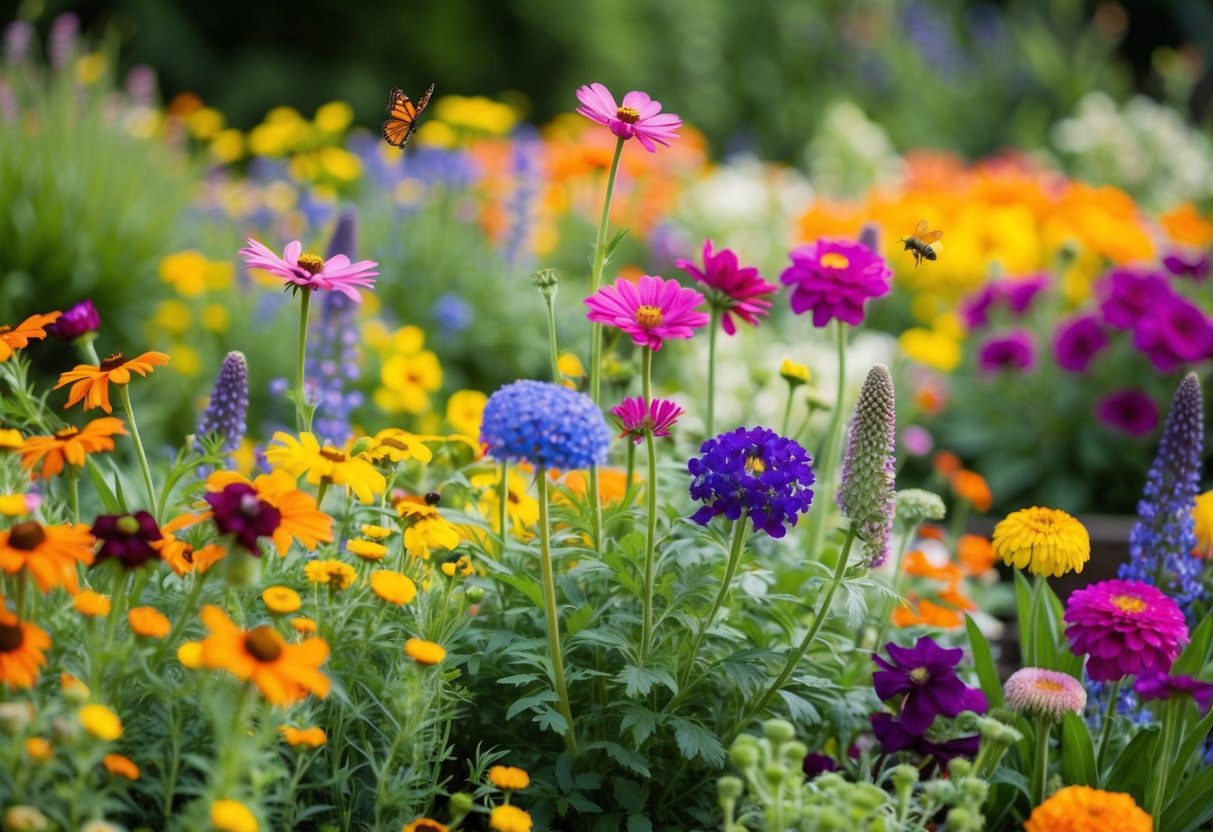
Peonies are known for their lush, fluffy blooms that appear year after year, offering long-lasting charm to any garden. Lavender is a great choice for edging, thriving in bright sun and adding a pleasant fragrance to your outdoor space. For a touch of contrast, catmint’s purple blooms pair well with other colorful flowers, and it has the bonus of multiple blooming seasons.
Incorporating these plants into your flower bed not only enhances visual appeal but also minimizes maintenance. With annual choices and perennials like lavender, you can create a landscape that blooms beautifully throughout the seasons. You’ll find that using a combination of these tried-and-true plants allows you to customize your garden design effortlessly, giving you more time to enjoy the beauty you’ve created.
Designing Your Flower Bed

Creating a beautiful flower bed involves choosing a color palette, arranging plants effectively, and selecting flowers to fit different garden themes. Your choices can enhance curb appeal and create a harmonious outdoor space that reflects your style.
Choosing a Color Palette
Decide on a theme: When selecting a color palette, think about the mood you want to create. A vibrant mix of yellows, reds, and oranges can bring energy, while blues and purples offer a calming effect. Your color scheme should fit with the existing elements of your garden or home to enhance visual interest.
Consider flower colors and textures: Use a variety of shades and plant shapes. For example, combining tall purple spikes with round red blooms can add contrast and depth. Mixing in different shades of green foliage can also complement your chosen flower colors.
Plan for seasonal changes: Choose plants that will bloom at different times of the year, providing year-round color. This approach will ensure that your flower bed remains vibrant and attractive across the seasons.
Layout and Layering Techniques
Create layers: Arrange plants in tiers to add depth to your garden beds. Place taller plants, like sunflowers or tall grasses, at the back. Mid-sized plants should fill the middle, with shorter varieties like groundcovers in the front for a layered look.
Consider plant shape and mature size: Make sure to choose plants with complementary shapes and be aware of their mature size to prevent overcrowding. This will help maintain a tidy and organized appearance as the plants grow.
Utilize raised beds: Raised beds can enhance drainage and add a structured element to your garden design. They also make it easier to manage soil quality and plant layer placement. Use these beds to highlight specific plants or create distinctive themed areas.
Selecting Flowers for Thematic Gardens
Cottage gardens: Choose soft colors and informal arrangements with flowers like hollyhocks, foxgloves, and roses. These create a relaxed and inviting feel.
Herb and potager gardens: Combine herbs with edible flowers to make the space both beautiful and practical. Plants like lavender, basil, and nasturtiums work well here, complementing the garden’s utility.
Mediterranean theme: Select hardy plants that thrive in hot, dry climates. Options like lavender, rosemary, and succulents are ideal. These choices not only suit the theme but are low-maintenance and perfect for sunny spots.
Choosing Plants for Your Flower Bed
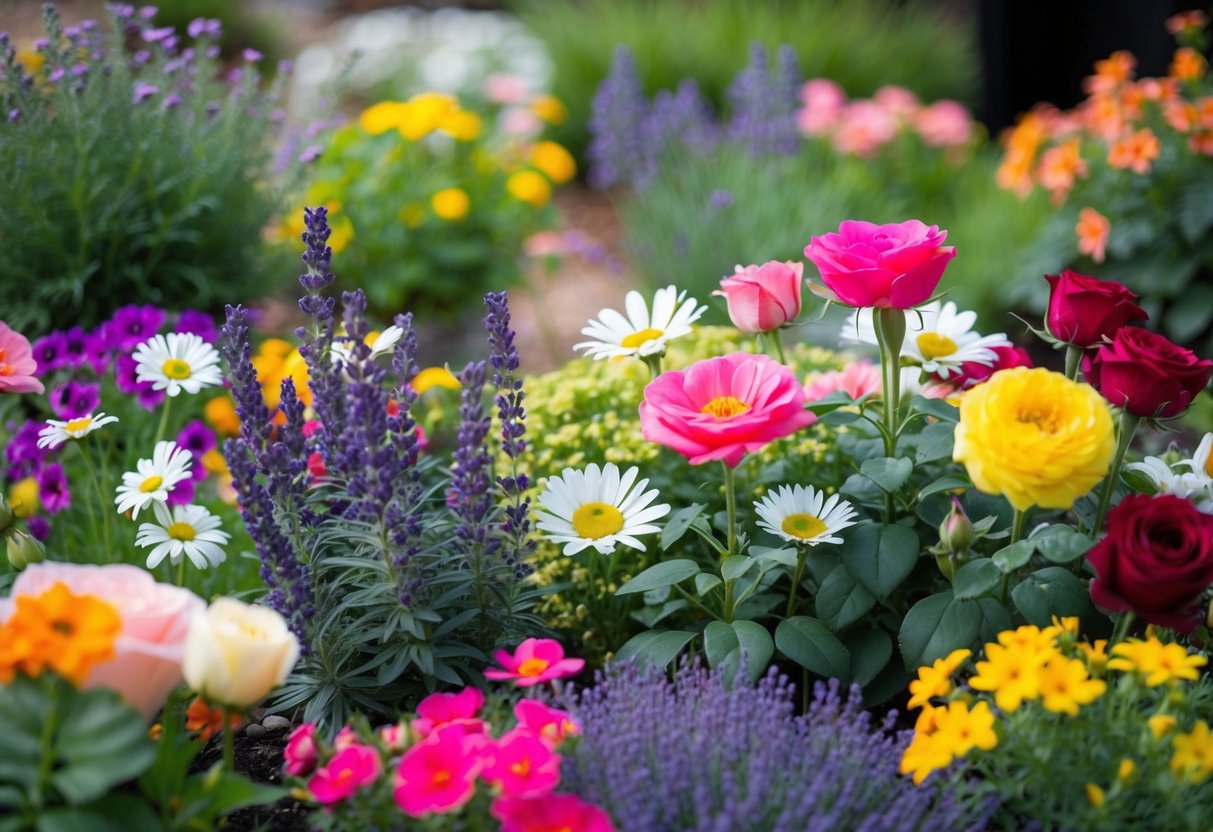
Creating a vibrant flower bed involves selecting the right plants that bring color and support local wildlife. You’ll want to consider both short-term and long-lasting blooms as well as choosing plants that attract helpful pollinators.
Annuals and Perennials
In a flower garden, it’s important to blend both annuals and perennials to enjoy blooms every season. Annuals like zinnias and pansies bring bright colors and can fill in gaps in your garden quickly. They’re perfect for adding visual interest and need to be replanted every year.
Perennials, such as daylilies, echinacea, and lilies, return year after year, offering a long-term investment for your garden. For instance, black-eyed susans and cone flowers are reliable choices that add height and draw pollinators. These plants are often drought-tolerant, making them ideal for saving water. Consider mixing annuals and perennials to maintain a diverse array of flowers throughout the seasons and ensure lasting beauty.
Native Flowers and Pollinator Plants
Native flowers play a critical role in your flower bed by supporting the local ecosystem. Species like bee balm and wildflowers naturally attract bees, butterflies, and other pollinators. These plants help improve the health of other plants in your garden, enabling them to thrive without added fertilizers or pesticides.
When selecting pollinator plants, lavender, sedum, and thyme stand out for their fragrance and resilience. These plants are drought-tolerant and can sustain pollinators during dry spells. Hellebore is another excellent choice for providing early spring blooms when food is scarce for pollinators. Incorporating a variety of pollinator plants ensures that your garden not only looks beautiful but also supports wildlife year-round.
Bed Preparation and Planting

Preparing and planting a flower bed is crucial for healthy plant growth. It involves soil preparation, which ensures your plants have a nutrient-rich environment, and thoughtful planting to achieve a visually appealing arrangement.
Soil Preparation
To start, focus on creating a healthy soil foundation for your flower bed. Begin by turning the soil over to a depth of at least 12 inches to allow roots to establish easily. Add compost or topsoil to enrich the soil with nutrients. This helps in retaining moisture and providing plants with essential nutrients.
You can add 2-3 inches of compost and mix it into the soil. This enhances soil texture and helps maintain a good drainage system while preventing weeds from taking over. At a garden center, you can find additional materials like mulch and organic matter to further enrich your bed.
Planting and Arranging
When it’s time to plant, consider the height and space requirements for each type of flower. Place taller plants at the back and shorter ones near the front for a tiered effect. This strategy also gives each plant the sunlight it needs to thrive.
Before planting, soak the area in the early morning to help roots establish well. Use gardening tools like a spade or hand fork when arranging your plants to ensure they fit well without overcrowding. Be mindful of soil type, as some plants prefer more acidic or alkaline conditions. It’s like putting together a puzzle, ensuring every piece fits perfectly and thrives.
Edging and Borders
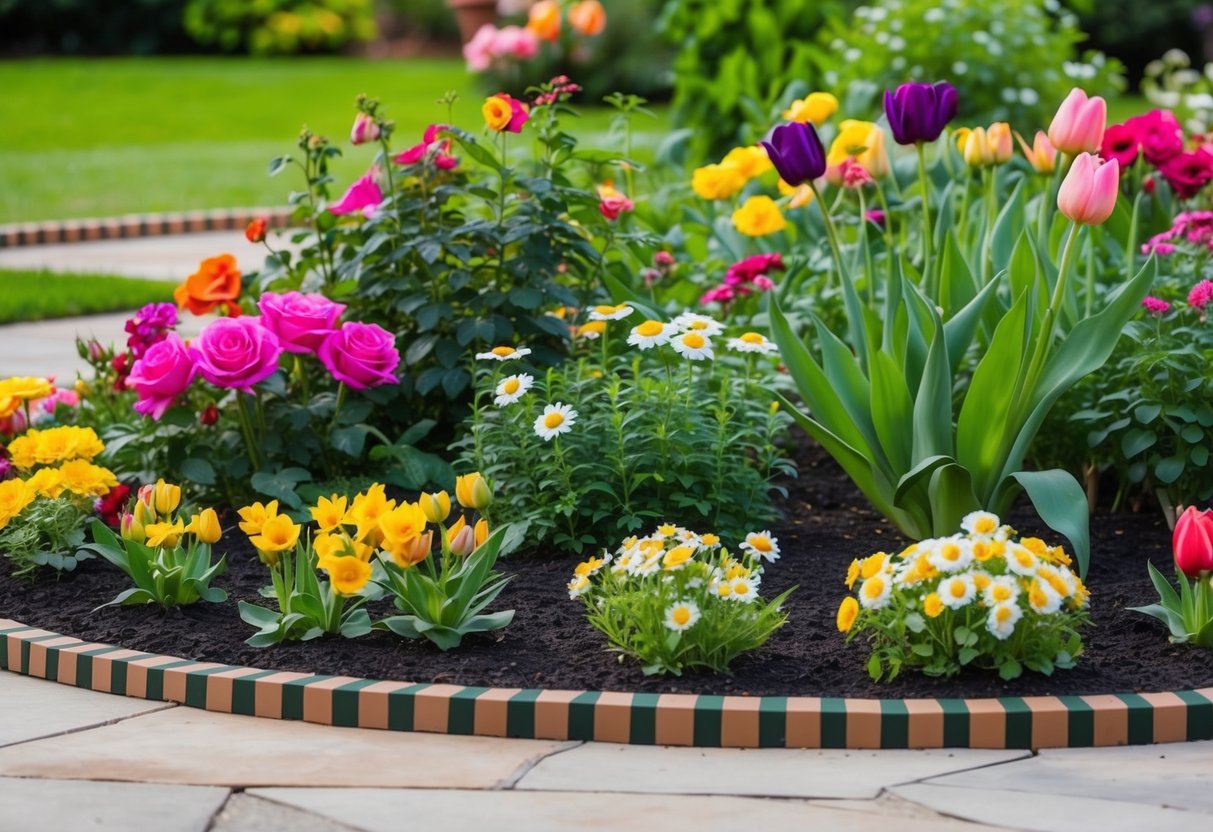
Edging and borders can transform your flower bed by adding structure and visual interest. They help keep plants in check and can add a decorative flair to your garden space.
Creating Defined Edges
Defined edges help keep your flower beds looking tidy and organized. One way to achieve this is by using raised beds. Raised beds not only give your garden a clean look, but they also help prevent soil erosion and improve drainage. For a more natural look, consider using materials like stone or wood for unique garden borders.
A stone pathway can create a clear line between your garden beds and walkways. This helps maintain order, especially if you have an intricate border garden design. Another effective method is to use a metal or plastic landscape edging. These materials are flexible and easy to install, allowing you to create smooth curves or sharp angles.
Decorative Edging Plants
Using plants as borders can add softness and color to your garden. Fragrant edging plants like lavender are excellent choices, as they provide scent and beauty. Lavender thrives in Zones 5-10 and is perfect for warm climates.
For a formal look, consider boxwood shrubs. Their compact shape and rich green color make them popular for neatly framed flower beds. If you prefer softer textures, try planting ferns or hostas. These plants offer lush green leaves that add depth and charm. Hostas, in particular, are great for shady spots and create a cool, serene border around your edging plants.
Ongoing Care and Maintenance
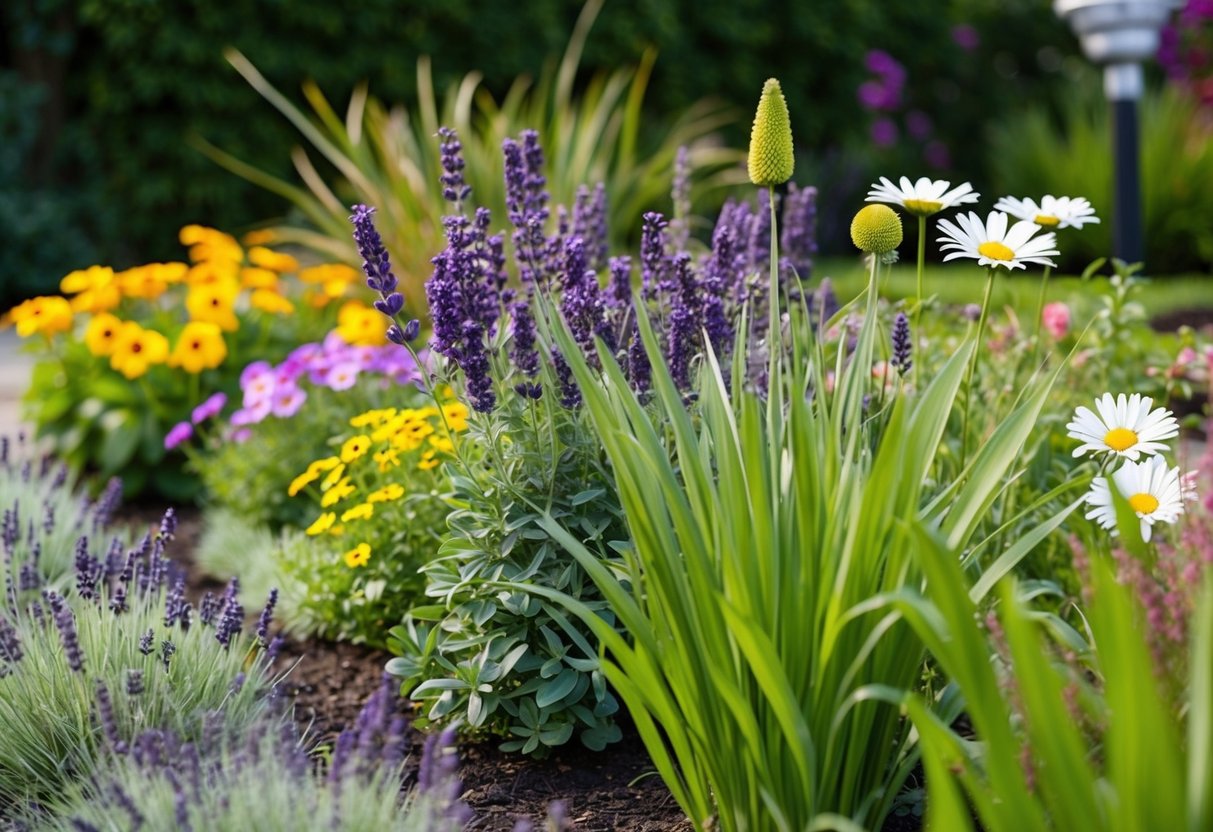
To keep your flower bed healthy and flourishing, regular care is essential. This involves tasks like watering and mulching, as well as fertilization and pruning.
Watering and Mulching
Watering your flower bed is vital for plant health. Flowers generally need about 1 inch of water per week, either from rainfall or supplemental watering. Early morning is the best time to water, as it reduces evaporation and helps prevent disease.
Mulching helps retain soil moisture, restricts weed growth, and regulates soil temperature. Apply a 2-3 inch layer of organic mulch, like wood chips or straw, around your plants. Avoid piling mulch against plant stems to prevent rot. Consistent mulching not only aids in water conservation but also adds nutrients to the soil as it breaks down over time.
Fertilization and Pruning
Fertilization keeps your flowers nourished. Select a balanced, slow-release fertilizer and apply it according to the package instructions. Many plants benefit from fertilization at the start of the growing season and again mid-season. Always avoid over-fertilizing, which can damage plants.
Pruning is crucial for removing dead or diseased parts of the plant and encouraging new growth. Use clean, sharp tools to make clean cuts. For a cutting garden, regular pruning can increase flower production. Identify and remove any faded blooms and trim back leggy growth to maintain the desired plant shape. Proper pruning ensures your flower bed stays vibrant and healthy throughout the season.
Additional Features and Considerations
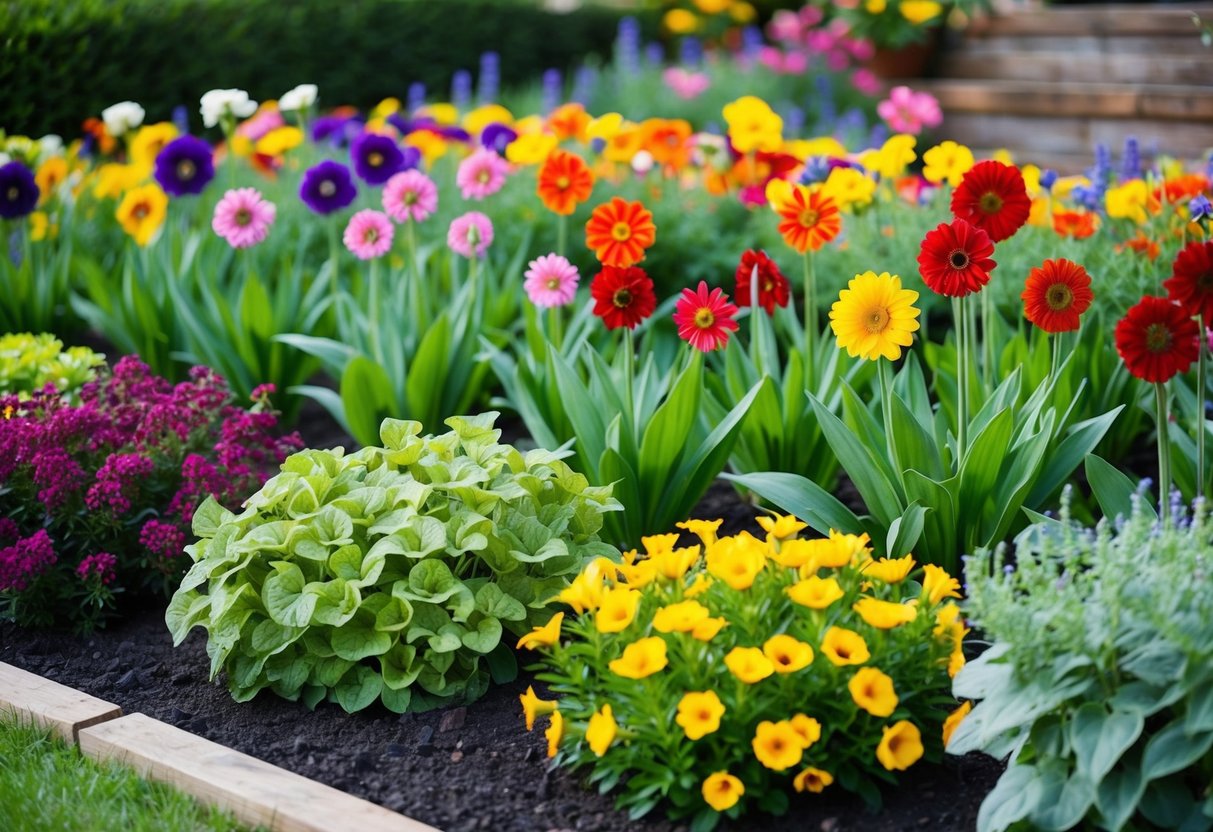
In a flower bed, adding unique elements can make it stand out. Consider using containers and including edible plants to enhance both appearance and use.
Accessorizing with Containers and Features
Using containers and features can add visual interest to your flower bed. Containers like pots or window boxes create different heights and layers, making your garden more dynamic. Choose pots that complement the colors of your flowers for a cohesive look.
Consider adding garden features such as small statues or a birdbath. These items can increase your garden’s curb appeal by providing focal points. Even simple green edging with shrubs can define spaces effectively.
Placement matters, so think about how these containers or features fit into your overall garden design.
Incorporating Edibles and Herbs
Incorporating edibles like tomatoes or strawberries gives your flower bed both beauty and utility. A mix of colorful vegetables and flowers can enhance visual appeal.
Herbs such as basil or thyme work well in a small corner or integrated within the flower bed. They are both decorative and useful for cooking, offering benefits beyond just appearance.
These plants can also attract pollinators, improving the health of your garden. Consider dedicating a section for your herb garden, making it easy to access fresh flavors for your kitchen. Using edibles can transform your flower bed into a functional space.







